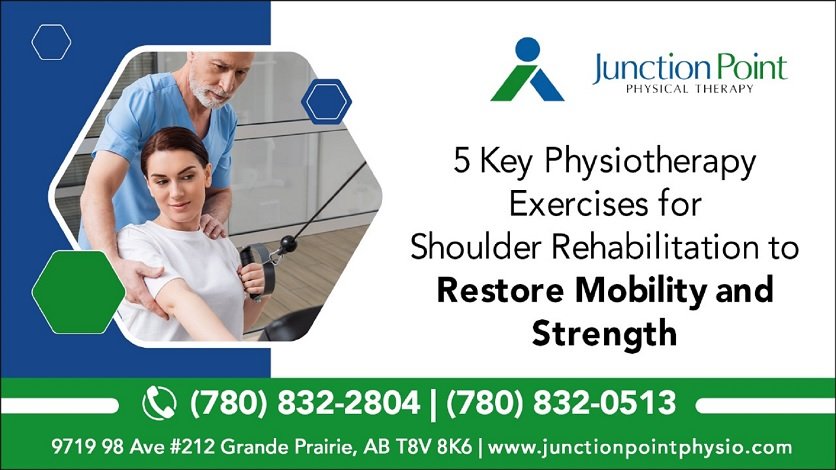Shoulder rehabilitation is a comprehensive process to restore normal function and strength to the shoulder joint following injury, surgery, or immobilization. The shoulder is a complex mobile joint essential for various activities, from simple daily tasks to complex athletic movements. Physiotherapy in Grande Prairie for shoulder rehabilitation addresses the unique challenges of shoulder injuries and aims to restore mobility, strength, and stability. Here’s an in-depth look at shoulder rehabilitation:
Understanding Shoulder Anatomy and Common Injuries
Shoulder Anatomy:
- Bones: The shoulder consists of three prominent bones—the humerus (upper arm bone), the scapula (shoulder blade), and the clavicle (collarbone). The shoulder joint, or glenohumeral joint, is where the head of the humerus fits into the shallow socket of the scapula.
- Muscles and Tendons: Key muscles include the rotator cuff (comprising the supraspinatus, infraspinatus, teres minor, and subscapularis) and the deltoid. Tendons in the shoulder, such as the rotator cuff tendons, are crucial for joint stability and movement.
- Ligaments: Ligaments connect bones, providing stability to the shoulder joint. Common ligaments include the acromioclavicular (AC) ligament and the glenohumeral ligaments.
Common Shoulder Injuries:
- Rotator Cuff Tears: It may cause damage to the rotator cuff, and tendons can cause pain and weakness, often resulting from overuse or acute injury.
- Impingement: Shoulder impingement may occur when the tendons of the rotator cuff become inflamed as they pass through the shoulder joint.
- Shoulder Dislocation: The humerus may forced out of the glenoid socket, often due to trauma or forceful movements.
- Labral Tears: Damage to the labrum, a cartilage ring around the shoulder socket, can lead to instability and pain.
- Frozen Shoulder (Adhesive Capsulitis): It may be caused by shoulder joint stiffness, restricting movement.
5 Physiotherapy Exercises for Effective Shoulder Rehabilitation
Shoulder rehabilitation benefits people through physiotherapy in Grande Prairie, which addresses specific aspects of recovery. Here’s a detailed look at five exercises, including instructions on how patients can perform each exercise effectively.
1. Neurodynamic Mobilization
Neurodynamic mobilization targets the movement and flexibility of the nerves passing through the shoulder region, such as the brachial plexus. This technique reduces nerve tension, helping alleviate nerve-related pain and discomfort.
How to Perform:
- Starting Position: Try to sit or stand with the back straight and shoulders relaxed.
- Movement: Extend one arm straight out before the palm facing up. Gently flex the wrist and fingers, slowly move the arm outward, away from the body, and tilt the head toward the opposite shoulder.
- Repetitions: Hold the position for 10-15 seconds, then return to the starting position. Repeat 3-5 times, gradually increasing the stretch as tolerated.
2. Pendulum Circles with Resistance Band
Pendulum Circles are a fundamental exercise in shoulder rehabilitation, particularly effective in the early stages of recovery. This exercise helps increase the range of motion in the shoulder joint.
How to perform:
- Starting Position: Secure a resistance band in a stable object at waist level. Stand with feet shoulder-width apart, holding the band in the hand opposite the injured shoulder. Lean forward slightly, letting the arm with the band hang freely.
- Execution: Swing the arm in small circles, gradually increasing the size as comfort allows. Keep the motion controlled and fluid.
- Repetitions: Perform 10-15 circles in one direction, then reverse. Complete 2-3 sets, adjusting as needed for comfort and progress.
3. Isometric Shoulder External Rotation
Isometric Shoulder External Rotation is critical in rehabilitating shoulder injuries, particularly those involving the rotator cuff. This exercise targets the rotator cuff muscles essential for shoulder stability and movement.
How To Perform:
- Starting Position: Stand with the injured shoulder against a wall, elbow bent at 90 degrees, and the back of the hand pressed against the wall.
- Execution: Press the hand into the wall without moving the arm, engaging the shoulder muscles. Hold for 10-15 seconds, keeping the body relaxed.
- Repetitions: Repeat for three sets of 10; adjust based on comfort and progress.
4. Proprioceptive Neuromuscular Facilitation (PNF) Stretching
PNF stretching combines stretching and muscle contraction to improve flexibility and strength. Techniques like contract-relax and hold-relax enhance the range of motion and neuromuscular coordination.
How to Perform:
- Contract-Relax Technique: Start by stretching the shoulder to the limit of its range. Then, isometrically contract the shoulder muscles against resistance for 5-10 seconds. After relaxation, gently pull the shoulder further.
- Hold-Relax Technique: Stretch the shoulder to the point of mild discomfort. Hold the stretch while contracting the muscles against resistance for 5-10 seconds. Relax and deepen the stretch.
- Repetitions: Perform each stretch 2-3 times, holding each position for about 20-30 seconds.
5. Scapular Retraction
Scapular retraction exercises are crucial in shoulder rehabilitation, as they target the muscles around the shoulder blades. Strengthening these muscles improves posture, stability, and overall shoulder function.
How to Perform Scapular Retraction Exercises
- Starting Position: Sit in a chair with your feet and hands resting on your thighs. When standing, place your feet shoulder-width apart with arms relaxed at your sides.
- Execution: Squeeze the shoulder blades together, directing them downward towards the spine. Hold the retracted position for 3-5 seconds, focusing on the muscles between the shoulder blades rather than the arms or shoulders. Release the squeeze and return to the starting position, ensuring the movement is controlled and deliberate.
- Repetitions: Perform 10-15 repetitions per set, completing 2-3 sets based on your goals and capabilities.
Find The Path to Shoulder Strength: Key Exercises for Effective Rehab
Consider physiotherapy in Grande Prairie for a shoulder rehabilitation program that is crucial for restoring mobility and strength. If someone seeks a “physiotherapist near me,” Junction Point Physical Therapy addresses various aspects of shoulder recovery. This physiotherapy clinic provides attention to promote healing and restore function, ensuring patients can return to their active lifestyles.
Visit Junction Point Physical Therapy in Grande Prairie for expert guidance in shoulder rehabilitation. This Grande Prairie physiotherapy clinic supports optimal recovery, helping patients confidently return to daily activities.
Read More: 5 Key Physiotherapy Exercises

